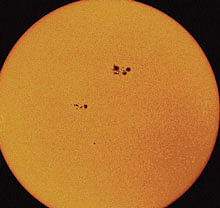Spotlight's on the sun

An analysis of satellite data challenges the intuitive idea that decreasing solar activity cools the earth, and vice versa. In fact, solar forcing of the earth’s surface climate seems to work the opposite way around – at least during the current sun cycle. Joanna Haigh, an atmospheric physicist at Imperial College London and her colleagues analysed daily measurements of the spectral composition of sunlight made between 2004 and 2007 by NASA’s Solar Radiation and Climate Experiment (SORCE) satellite.
They found that the amount of visible light reaching the earth increased as the sun’s activity declined – warming the earth’s surface. Their unexpected findings are published in Nature. The study period covers the declining phase of the current solar cycle. Solar activity, which in the current cycle peaked around 2001, reached a pronounced minimum in late 2009 during which no sunspots were observed for an unusually long period.
Sunspots, dark areas of reduced surface temperature on the sun caused by intense magnetic activity, are the best-known visible manifestations of the 11-year solar cycle. They have been regularly observed and recorded since the dawn of modern astronomy in the seventeenth century. But measurements of the wavelengths of solar radiation have until now been scant.
Radiation leak
Haigh’s team compared SORCE’s solar spectrum data with wavelengths predicted by a standard empirical model based mainly on sunspot numbers and area, and noticed unexpected differences.
The amount of ultraviolet radiation in the spectrum was four to six times smaller than that predicted by the empirical model, but an increase in radiation in the visible wavelength, which warms the earth’s surface, compensated for the decrease. Contrary to expectations, the net amount of solar energy reaching earth’s troposphere – the lowest part of the atmosphere – seems to have been larger in 2007 than in 2004, despite the decline in solar activity over that period. “Our findings could be too important to not publish them now.”
The spectral changes seem to have altered the distribution of ozone molecules above the troposphere. In a model simulation, ozone abundance declined below an altitude of 45 kilometers altitude in the period 2004-07, and increased further up in the atmosphere. The modeled changes are consistent with space-based measurements of ozone during the same period. “We’re seeing – albeit limited to a very short period – a very interesting change in solar irradiation with remarkably similar changes in ozone,” says Haigh. “It might be a coincidence, and it does require verification, but our findings could be too important to not publish them now.”
Sun surprise

The full implications of the discovery are unclear. Haigh says that the current solar cycle could be different from previous cycles, for unknown reasons. But it is also possible that the effects of solar variability on atmospheric temperatures and ozone are substantially different from what has previously been assumed. “At face value, the data seem incredibly important,” says Michael Lockwood, a space physicist at the University of Reading, UK.
“If solar activity is out of phase with solar radiative forcing, it could change our understanding of how processes in the troposphere and stratosphere act to modulate Earth’s climate.”
“At face value, the data seem incredibly important.” Some meteorologists believe, for example, that during phases of low solar activity, ‘blocking events’ – unusual patterns in westerly air currents that can cause cold snaps and freak weather in Europe – occur more frequently. A blocking event is thought to have caused the southward transport of ash clouds following the eruption in March of the Icelandic volcano Eyjafjallajokull, which disrupted air traffic throughout Europe. But any links between recent weather anomalies and possible peculiarities in the current solar cycle are speculative for now, says Lockwood.
Changed understanding
Over the three-year study period, the observed variations in the solar spectrum have caused roughly as much warming of earth’s surface as have increases in carbon dioxide emissions, says Haigh. But because solar activity is cyclic it should have no long-term impact on climate, regardless of whether similar spectral changes have occurred during previous solar cycles.
“If the climate were affected in the long term, the sun should have produced a notable cooling in the first half of the twentieth century, which we know it didn’t,” she says. The idea that scientists might not have quite understood the sun’s effect on climate should not provide ammunition for climate-change skeptics, says Martin Dameris, an atmospheric scientist at the German Aerospace Center in Oberpfaffenhofen.
“The findings could prove very significant when it comes to understanding, and quantifying, natural climate fluctuations,” he says. “But no matter how you look at it, the sun’s influence on current climate change is at best a small natural add-on to man-made greenhouse warming.” “All the evidence is that the vast majority of warming is anthropogenic,” agrees Lockwood. “It might be that the solar part isn’t quite working the way we thought it would, but it is certainly not a seismic rupture of the science.”
Future measurements – ideally overlapping data from different satellite instruments – should help to clear up the matter. But testing the accuracy of Haigh’s provisional findings will require at least a full 11-year solar cycle of high-quality spectral observations. “We’re waiting with bated breath for these data to turn up,” says Haigh.
Deccan Herald is on WhatsApp Channels| Join now for Breaking News & Editor's Picks